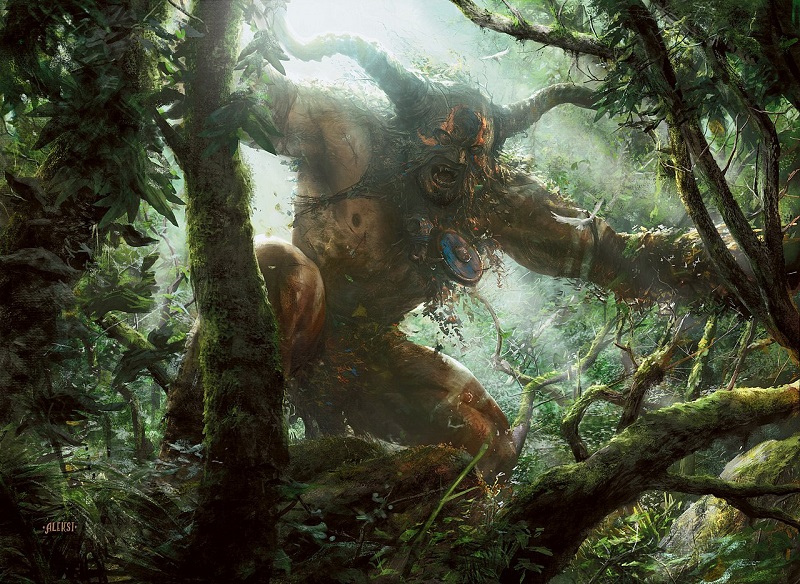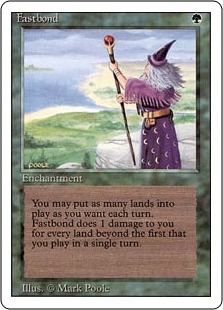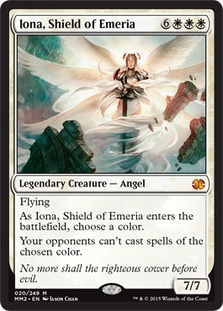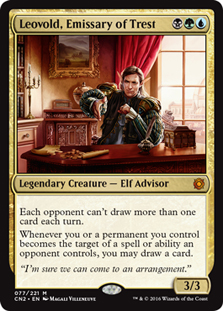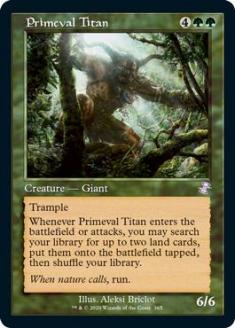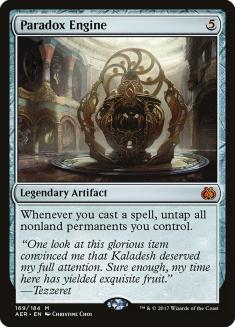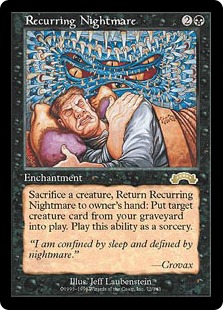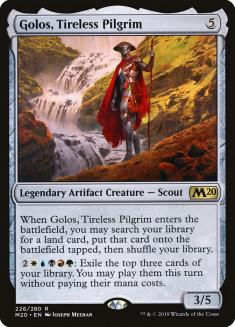The Banned List is the most contentious element of Commander. One of the reasons this is the case is that we on the Commander Rules Committee (RC) manage it differently from every other format out there, and intentionally so. While most formats seek competitive balance, we’re crafting something different.
Today we’ll discuss that difference, focusing on the anatomy of a banned card. I’ll break down the reasons for which we might ban a card, which will also lead into some reasons why we might not. We don’t have time or space to do a micro-dive into each card on the Banned List, but I’ll use a few as example. First, let’s lay some groundwork.
A primary difference between Commander and other formats is that we don’t use the Banned List as our only tool. We’re the only one with a philosophy document and it guides how we shape things. We make liberal use of positive player engagement and encouragement regarding the play styles we see as best at creating positive experiences for the broadest audience (while in no way casting aspersions on those who prefer different ones).
We see the format as more than a set of rules and list of cards you can’t play. Commander is an ethos. It’s about the social experience as much as the tactical one of the game itself. Yes, we realize that it’s a game and it has oppositional elements in which someone must eventually win, but we still see Commander as a format in which you play with other people, not against them.
While I’ll encourage you to read the entire Commander Philosophy Document, I want to point you to a few relevant pieces here:
The phrase positive player experience is doing the heavy lifting there. While we can’t get rid of every card that creates feel-bads, we can use our experience, observation, and player feedback to tackle the worst offenders. We also mention them as examples, which hopefully gets players thinking about similar cards that they might want to consider not playing with. The other big part of that sentence talks about preventing players from reasonable self-expression. We believe that the best Commander games are ones in which everyone has a chance to play their cards. If other cards shut down that ability, we’ll take a hard look at them.
The other section of the Philosophy Document I’ll highlight is the list of reasons for banning a card. This isn’t a checklist or a prescription, but an explanation of some of the characteristics that we find challenging to the positive player experience.
While the cards on the Banned List tend to fit into one or more of the categories, there are others that might fit that don’t end up banned. Generally speaking, the ones that don’t get banned are cards that aren’t getting played in great numbers in the format. A card might be miserable, but if not many people are playing it, there’s no need to ban it. We want to keep the Banned List as short as possible as one step in making the format as accessible as we can. This means that we’ll err on the side of leaving a card unbanned if it’s in the gray area.
In breaking down the anatomy of a banned card, I want to talk about it in two overarching categories:
- What a card does to a game
- What a card does to the format
The former speaks to what impact a card has in the microcosm; the latter, what it means in the macrocosm. Sometimes, only one of those needs apply to make a card bannable. In more cases, it’s a combination of both, since the first often leads into the second. As we engage in this discussion, we can reference back to the list of the kinds of things that can get a card banned. Again, it’s not an exhaustive list, but it definitely hits the high points. Having a single attribute might get a card banned if it does that thing to an extreme degree. A card that does multiple things on the list is an even greater candidate. Remember, these are cards that can easily or excessively do the following:
- Cause severe resource imbalances
- Allow players to win out of nowhere
- Prevent players from contributing to the game in a meaningful way
- Cause other players to feel they must play certain cards, even though they are also problematic
- Are very difficult for other players to interact with, especially if doing so requires dedicated, narrow responses when deckbuilding
- Interact poorly with the multiplayer nature of the format or the specific rules of Commander
- Lead to repetitive gameplay
We’ll return to this list in the course of discussing the two broad categories I mentioned. As we do, I want to be sure you understand that I’m talking about this in the academic sense, using some practical examples. It’s not my intention in this piece to try to categorize why each individual card is on the list. I will, however, tell you that one of the projects we’re working on is having a feature on the RC website that does just that — it’ll be a rollover for each card, so that when you hover the mouse, instead of just getting a card image, you’ll get an explanatory paragraph. More on that as it develops.
What a Card Does to a Game
A card wrecks a game by:
- Doing too much for one player
- Doing too much to an opponent
- Overcentralizing the game
- Creating what we and many players believe lead to poor quality experiences for the broadest part of the player base
Doing too much for one player means giving them a disproportionately large resource advantage at one time. “Too much mana too fast” is a familiar refrain for a card like Tolarian Academy or Channel. Fastbond fits in that area as well. Some folks ask about Gaea’s Cradle as a Tolarian Academy equivalent. We recognize that while Gaea’s Cradle will eventually produce more mana than Tolarian Academy, it does so on later turns. Hullbreacher’s asymmetrical effect puts it here as well.
Doing too much to an opponent means easily taking them out of the game or preventing them from really getting into it. We really want players to be able to do stuff. While sometimes figuring your way out of a Stax or other resource denial puzzle can be a rewarding challenge, it can also be a real slog most of the time. Limited Resources and Iona, Shield of Emeria make good examples of this criterion at opposite ends of the mana cost spectrum. Leovold, Emissary of Trest; Braids, Cabal Minion; and Erayo, Soratami Ascendant are examples whose problems are amplified by the fact that they can come out of the command zone.
Cards that overcentralize the game shift the focus from broad to very narrow, making a game all about that specific card until it either wins the controller the game or is removed. The poster child for this is Primeval Titan, which also could have been included in the paragraph on doing too much for one player. When Prime Time was legal, the game became all about that one card. It became a case of everyone trying to copy or steal it so that they, too, could rev up its value engine.
Finally, we have cards that just create undesirable games or play patterns. Some of these are cards that we refer to as sometimes “unintentionally wrecking games.” Paradox Engine is a good example. In addition to fitting into doing too much for a player and overcentralizing games, it’s one of those cards that players can jam into decks because it’s a value engine. Without a strong or consistent plan (or even sometimes with one), it creates situations in which the controller dominates the play clock (yes, I understand we don’t have actual clocks) but doesn’t move the game forward. Having a player take a fifteen- or twenty-minute turn isn’t a great experience for everyone else; for the player to then not win the game at the end of it might be even worse than if they did.
Recurring Nightmare is another good example. If it were legal, it might not break the format, but due to the nature of the card, it’s difficult to interact with. “Counter this now or die” isn’t desirable in the first place; “counter this now or be forced to watch someone eke out their value engine” is even less so. You can potentially interact with Recurring Nightmare a little more than that with graveyard hate, but not much.
Upheaval and Sway of the Stars go in the solitaire side also, with the active player being the only one who can float mana and recast what got bounced/cast what they drew. The success of unbanning Worldfire might offer some hope to folks who want Sway of the Stars; it’s probably on the other side of the line still, but it’s a conversation worth having. I suspect that Upheaval is still too inexpensive to cast and easy to abuse.
We understand that the whole idea of using “creates the kinds of games we think are unhealthy for the format” as part of the banning calculus doesn’t sit well with some folks. They’re used to the hard data-driven criteria from competitive formats and/or they disagree with us on what “healthy” means. I think it helps to consider that we’re not trying to accomplish the kind of balance other formats are. We don’t want things tipping over, like with Golos, Tireless Pilgrim, but that was an extreme example that also had other implications.
If all the Commander games you ever play are simply fun, then we’ve gotten to where we want to be (which is probably one of those things you know you’ll never achieve, but it’s worth it to still strive for anyway). The format is broad enough and there are enough self-selecting groups and pockets of play styles that it doesn’t need the same kind of balance that tournament formats do — and it might be so large that it’d be impossible to do without a significant change to the size of the Banned List — like an order of magnitude change. That’s a step we’re not willing to take. Also, no one wants to play against Shahrazad.
What a Card Does to the Format
Although there’s no such thing as a global Commander metagame in the sense that Magic players tend to use the term, there are cards that impact the format at a meta-level. Their presence is as meaningful as what they do, sometimes even moreso. They create a situation in which players feel they have to be ready to see the card in any game they sit down to and that they need to have answers for it, the latter part being the important distinction. You might see Solemn Simulacrum everywhere, but it’s not turning games on their head the way that Prophet of Kruphix did.
When cards get to the “play it or be prepared to play against it” stage, they’ve had format-warping impact. Primeval Titan’s ability to create value in a game was small compared to its meta-impact. Flash was an extreme example of what it was doing to a small portion of the community, but it was so omnipresent and impactful there that it warranted action.
Sometimes, what a card does to the format is difficult to quantify, but we know something is wrong when we see it. As I mentioned earlier, Golos was also a victim here. As such a generically good five-color commander that could lead nearly any deck, it was pushing out diversity. We’d like to give some of the other 1200+ legendary creatures a little more opportunity to shine.
All the cards previously banned under the Perceived Barrier to Entry criterion go here, even if they fit the other side as well. It was very important to us (and still is, really) that Commander not be seen as alt-Vintage, so cutting the Power 8 (Timetwister had slipped out of favor for a very long time) was easy. From the get-go, we wanted EDH to be a slower, more social game. Association (or confusion) with an early-turn, combo-win format was contrary to our goals. Even at the time, the cards were very expensive, but PBtE was less about that than it was about sending us in the direction of a format more open to the casual, less-enfranchised player.
When a single card dictates the deckbuilding choices of many other players, it has crossed the what-it-does-to-the-format line. While we encourage players to run various kinds of interaction, being forced to cut your deck from 100 cards to 100 minus X so that you can deal with a specific card isn’t a healthy direction. We want Commander to be the home of the decks and power levels you can’t play anywhere else. If a card gets in the way of that, it has to go.
While shaping Commander is more than just telling you what cards you can’t play, the Banned List is a big part of it. At the end of an ideal game, everyone will have done something and felt like they contributed to the game’s narrative; perhaps something epic happens (and then someone wins, rightly parenthetically). Banning some cards aids in achieving that goal. We also have the goal of keeping the number as small as reasonable so as to remain accessible to more than just the heavily enfranchised player.
We might not have or need the kind of hard data that tournament formats require, but we do have a thought process and guiding principles. With a number of criteria in mind, we look at what a card does inside games to make sure they’re not creating what we see as undesirable experiences. We also look at what they do to the format as a whole to make sure the basic environment is healthy. Even then, it’s not simple formula or an exact science. We could ban a few more cards and/or take a few off of the list and remain consistent with our philosophy. There is plenty of method in this madness.
As always, if you’re interested in productive conversation on this often-controversial subject or any other, head on over to the RC Discord server, where you can find good-faith chats in the #format-philosophy channel. Here’s hoping we see you there.
Visit my Decklist Database to see my Signature Decks, the Chromatic Project, and more!

